
Original Link: https://www.anandtech.com/show/6188/avadirect-silent-gaming-pc-system-review-part-ii-can-ivy-bridge-and-kepler-make-up-the-difference
AVADirect Quiet Gaming PC System Review Part II: Can Ivy Bridge and Kepler Make Up the Difference?
by Dustin Sklavos on August 27, 2012 12:01 AM EST- Posted in
- Systems
- AVADirect
- Ivy Bridge
- quiet
- Kepler
Re-Introducing the AVADirect Quiet Gaming PC
The last time we reviewed AVADirect's Quiet Gaming PC was in January. I was mostly pleased with it, but it went awry in the places that boutique systems often do: a questionable choice of case and a sub-optimal overclock. Worse, under sustained load the system generated audibly more noise than my own desktop, at the time a 4GHz Intel Core i7-990X cooled with a CoolerMaster Hyper 212+ and a pair of Scythe low speed fans, inside a SilverStone FT02. Compared to the silent machines Puget Systems produces, I felt it was underwhelming.
So today, AVADirect is back for round two. They've tried to take our criticisms to heart and produce a silent (or at least low noise) machine that they're convinced is going to hit the sweet spot. While I remain a bit skeptical, they have the benefit of a new generation of more powerful, more efficient hardware. Is their second go a better performer than the first, or are they still running into the same problems?
.jpg)
Part of my skepticism stems from the fact that one of my biggest complaints has apparently gone unaddressed. There are good cases out there that run quietly, but the NZXT H2 is not one of them. I reviewed the H2 quite some time ago and found it wanting, and it was one of the points that I brought up in the conclusion of my last review. NZXT's design itself isn't flawed in any kind of unresolvable way, but NZXT hasn't resolved it, and none of the boutiques employing the H2 have resolved it either. My hope is that the rest of the build is able to pick up the slack.
What has changed in the interim, outside of the new generation of hardware inside the system, is that AVADirect went and had their build certified by Silent PC Review. Whether or not I or you think any review site should be certifying products from vendors (beyond the conventional editor's choice or recommendations) is up for debate (for the record, Puget Systems also has an SPCR-certified Serenity model which we reviewed), but the conditions of the certification at least are promising: the system has to idle at or below 20dBA, can't meet or exceed 27dBA under load, and essentially has to be a good acoustic (and thermal) citizen.
| AVADirect Quiet Gaming PC (SPCR Certified) Specifications | |
| Chassis | NZXT H2 White |
| Processor |
Intel Core i7-3770K (4x3.5GHz + HTT, Overclocked to 4.5GHz, 22nm, 8MB L3, 77W) |
| Motherboard | ASUS P8Z77-V Pro/Thunderbolt |
| Memory | 4x4GB Crucial DDR3-1866 (max 4x8GB) |
| Graphics |
ASUS NVIDIA GeForce GTX 680 DirectCU II (1536 CUDA cores, 1019MHz/6GHz core/memory, 256-bit memory bus) |
| Storage |
OCZ Vertex 3 120GB 6Gbps SSD Western Digital Caviar Green 1.5TB 6Gbps HDD |
| Optical Drive(s) | Optiarc DVD+/-RW |
| Power Supply | Seasonic X-850 850W 80 Plus Gold |
| Networking |
Atheros AR9485 802.11b/g/n Intel 82579V Gigabit Ethernet |
| Audio |
Realtek ALC892 7.1 surround jacks |
| Front Side |
Optical drive Card reader |
| Top |
Headphone and mic jacks 3x USB 2.0 1x USB 3.0 Fan controller |
| Back Side |
PS/2 port HDMI (IGP) DVI (IGP) VGA (IGP) Optical out 4x USB 3.0 Ethernet 7.1 surround jacks Thunderbolt Secondary internal fan controller 2x DVI (GTX 680) HDMI (GTX 680) DisplayPort (GTX 680) |
| Operating System | Windows 7 Home Premium 64-bit SP1 |
| Extras |
80 Plus Gold power supply USB 3.0 Card reader Optimized for silent operation Thunderbolt |
| Warranty | 3-year parts and labor |
| Pricing |
Starting at $957 Price as configured: $2,755 |
At roughly $2,755 our second round is about as pricey as our first round was, but we have a couple of good reasons for it this time. While the Intel Core i7-3770K (with a very respectable 4.5GHz overclock) is par for the course on boutique systems, AVADirect has gone with a very high end air cooler (as most silent systems do) instead of the usual closed loop liquid cooler. The Prolimatech Megahalems is not a cheap cooler by any stretch of the imagination.
Another major expense is bound to be the ASUS P8Z77-V Pro/Thunderbolt motherboard. Motherboards equipped with Thunderbolt are very gradually becoming more numerous, but the Thunderbolt controllers themselves are still pretty expensive, and the P8Z77-V Pro is a fairly premium motherboard to begin with before you start tacking on that kind of functionality. I can appreciate and admire that AVADirect decided to go whole hog on the board, though.
Finally there's the NVIDIA GeForce GTX 680, specifically the ASUS model AVADirect is using. This card is actually even more monstrous than the GTX 580 version found in the last model we were sent, sporting a triple-slot cooler, five heatpipes, and two large fans to keep the card cool. While AVADirect elected not to overclock or tweak the GTX 680, performance should be plenty adequate.
The rest of the build is par for the course, which is why it continues to seem so bizarre that they're sticking with the NZXT H2. There isn't really anything else cheap about this design (you might argue the OCZ Vertex 3, which is one of the more affordable SF-2200 SSDs), so why drop the ball here?
Application and Futuremark Performance
The 4.5GHz overclock AVADirect was able to coax from the Intel Core i7-3770K at the heart of their Quiet Gaming PC coupled with the relatively speedy SandForce-based SSD should give it at least a decent foothold in our performance charts. It's a notch below the 4.6GHz that Origin was able to get out of the Chronos's i5-3570K, but these speeds are about the limit of Ivy Bridge's potential before heat becomes too much of a problem.
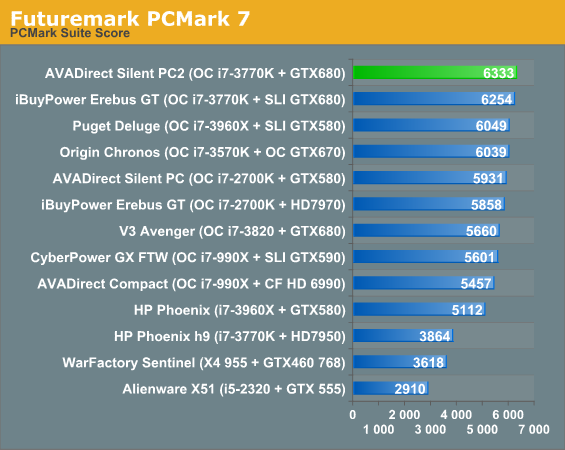
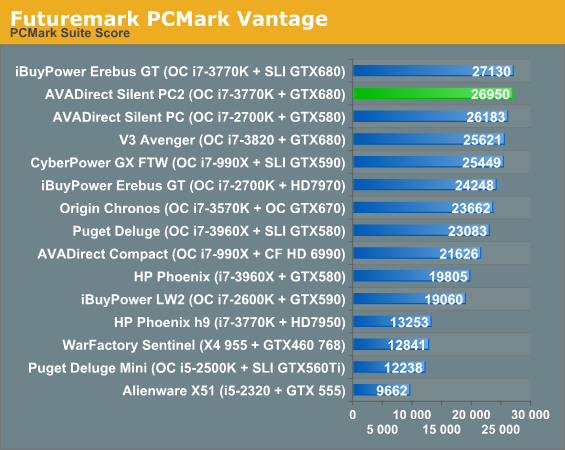
Out of the gate, AVADirect's system is looking pretty strong. The overclock and SSD have definitely given them a foothold. When we isolate the CPU from the rest of the system we should see similar results.
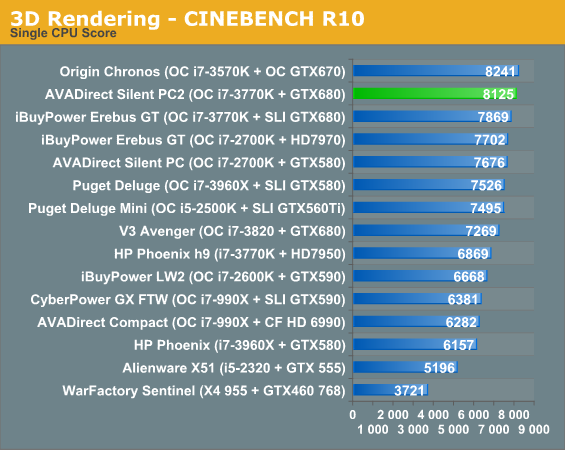
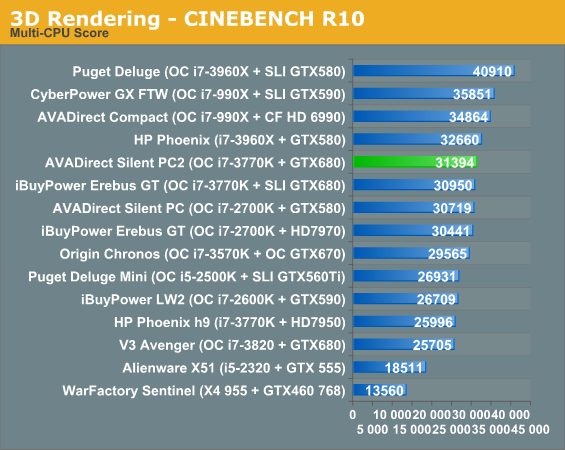
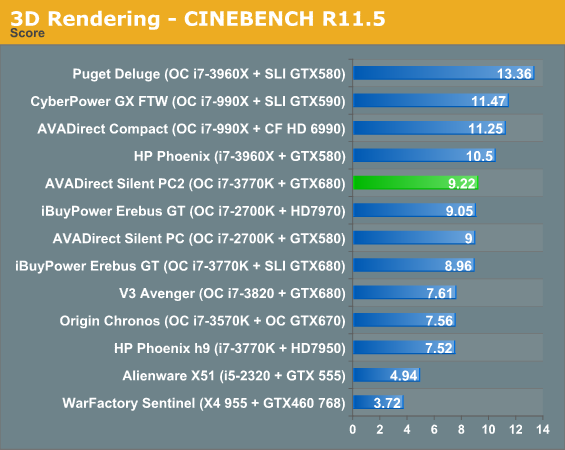
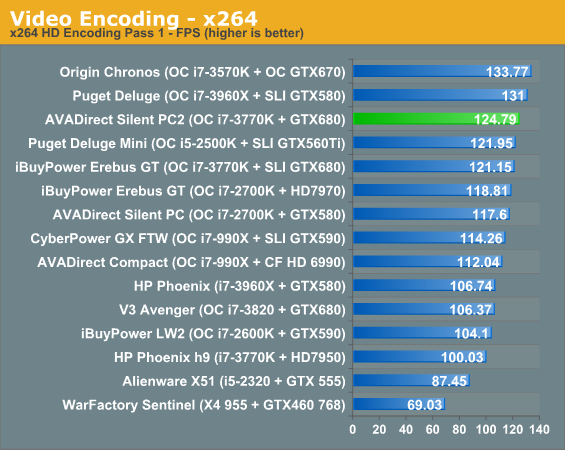
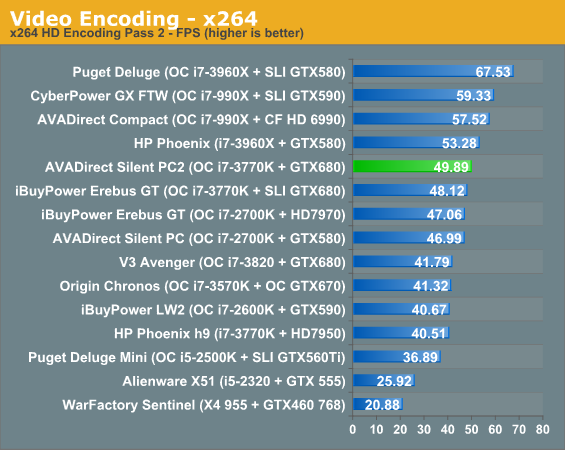
The CPU-limited results pretty much fall in line exactly where you'd expect. Anything that can leverage additional cores in the hexa-core systems does so, while the Origin Chronos's slightly higher clock speed gives it an advantage in certain situations.
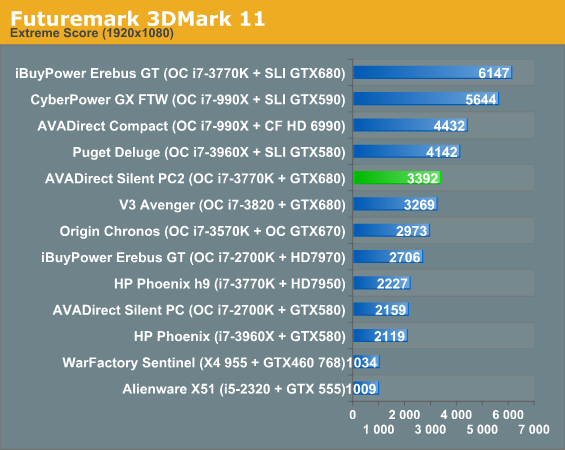
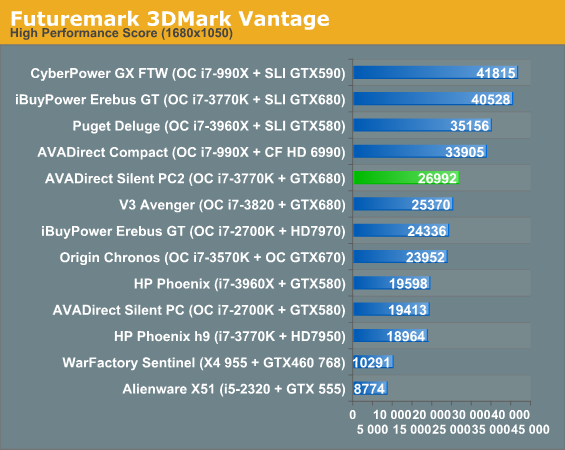
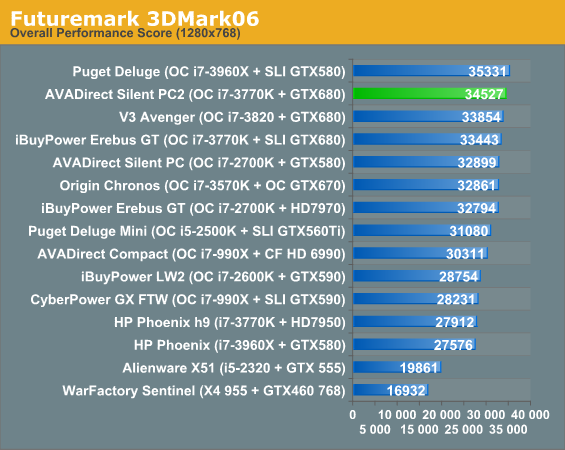
The more recent 3DMarks plant AVADirect's system right behind the multi-GPU equipped builds, while 3DMark06 is essentially CPU limited. While I'm tempted to retire it, I do find the results fairly interesting as it presents gaming situations where a CPU can actually hold back the rest of the system's performance. Recent games seem to be hitting CPUs a lot harder than they used to, and CPU overclocks have in turn been able to produce modest gains even at otherwise GPU-limited resolutions.
Gaming Performance
At this point, the NVIDIA GeForce GTX 680's gaming prowess should be relatively well known. AVADirect has elected not to pursue any performance tuning on the GTX 680, but the boost clock should do most of the work for them anyhow given the high thermal headroom of the massive heatsink and fan unit on the card. I do appreciate that NVIDIA got with the times with the Kepler generation and supports more than two simultaneous video outputs (allowing us to test single card systems at surround resolutions); they've even done one better than AMD in this case by not requiring the third video output to be DisplayPort.
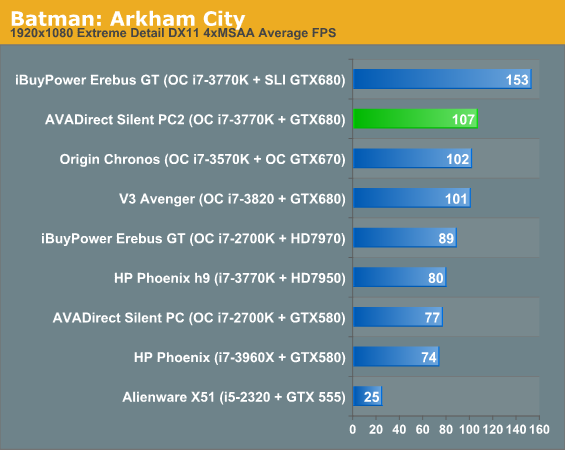
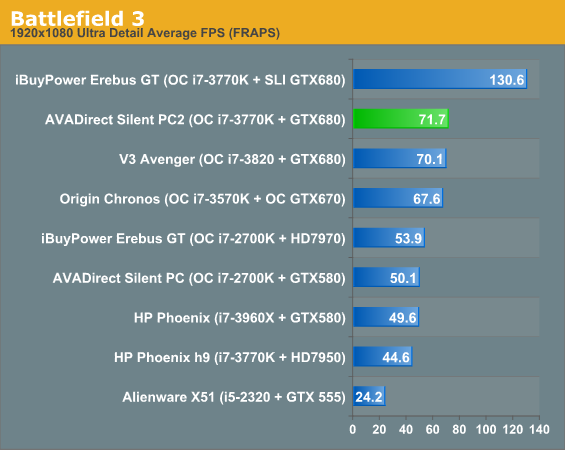
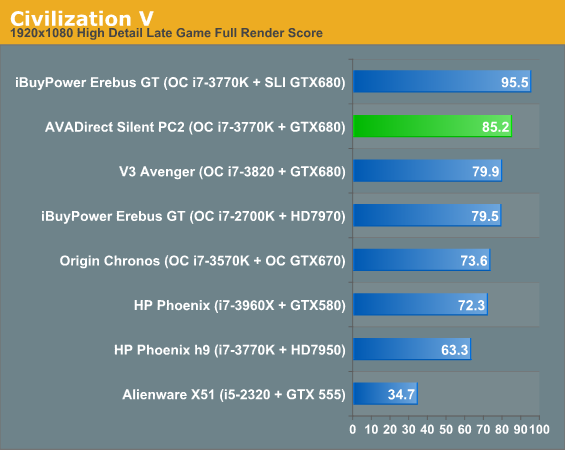

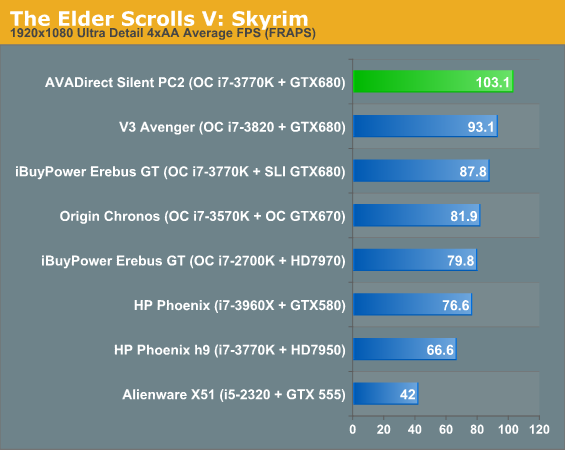

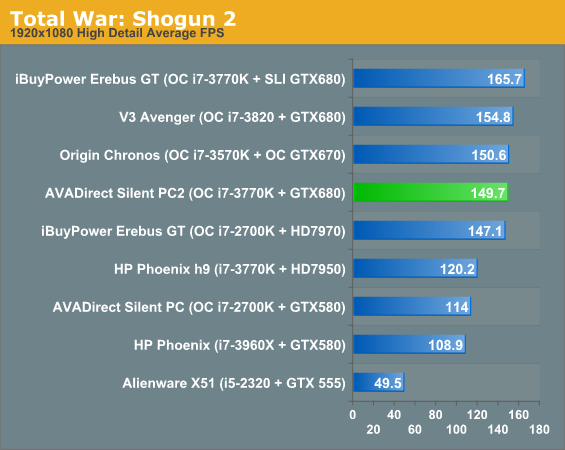
1080p hasn't been an issue for the top end of this generation or the last one; we frequently run into situations where systems are CPU limited. Surround testing is what really pushes modern graphics hardware.
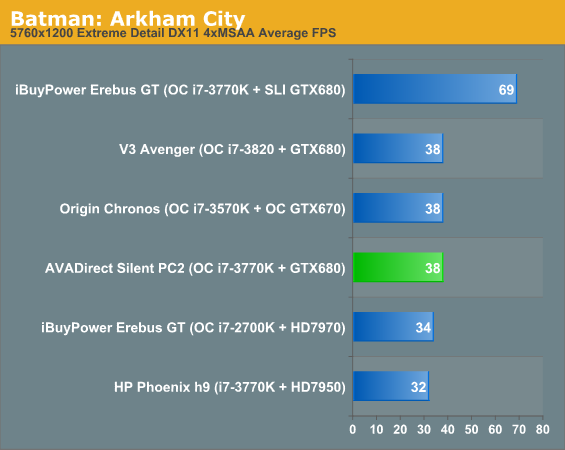
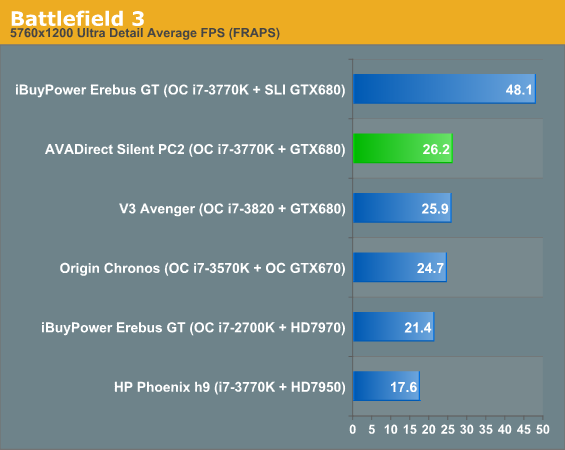
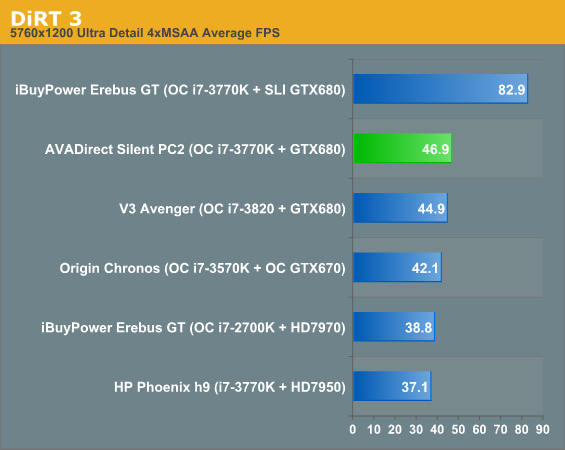
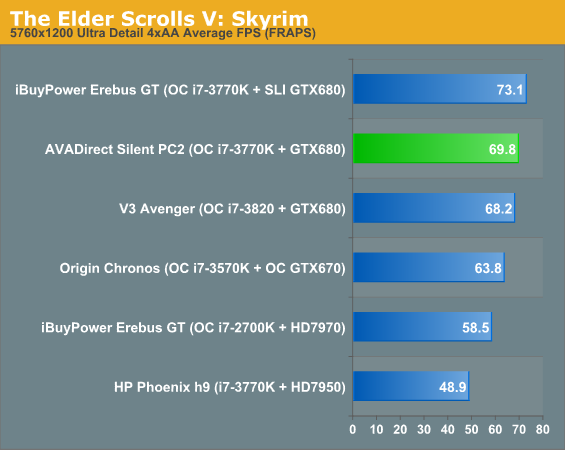
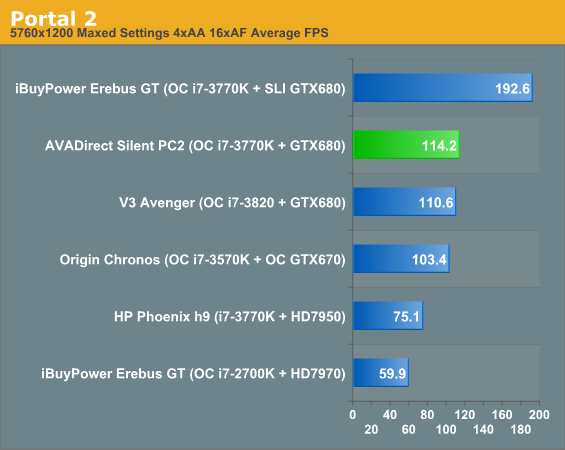
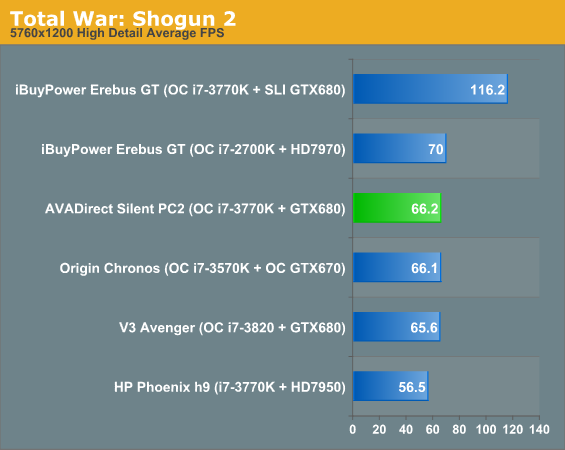
For the most part, the surround results line up about where you'd expect. The GTX 680 is a strong performer that really only loses its footing in Batman: Arkham City (with its abysmal DirectX 11 implementation) and Battlefield 3 (which just punishes graphics hardware anyhow). People who want to game in surround on this system will have no problem doing so.
Build Quality
Once again, it's pretty hard to fault AVADirect's building job. This Quiet Gaming PC seems to have even gotten a little bit of extra thought and care put into it compared to its predecessor, and more TLC is never a bad thing. Of course, AVADirect also benefits from the reduced power consumption of Ivy Bridge and Kepler, though the benefits of Ivy Bridge are mitigated by the heat produced at high overclocks (much like the 4.5GHz overclock in our review system).
.jpg)
Unlike in the last version, AVADirect has actually opted to move the video card down a slot and instead placed an independent fan unit between the card and the CPU heatsink in order to improve circulation. This is an interesting choice, but it benefits from the speed boost provided by PCI Express 3.0; even though the GTX 680 is forced to run on eight lanes instead of sixteen, the increased bandwidth works out to the same amount of bandwidth the card would've had to work with in a PCIe 2.1 x16 slot. That means the CPU gets a little more breathing room while the GTX 680 takes a virtually nonexistent performance hit. Smart move.
Heat and Noise
True to form, the AVADirect Quiet Gaming System is, indeed, quiet. I can't verify the certification by SPCR; most sound meters don't read below 30dB, so testing to see if those figures are accurate just isn't possible. I can say it's definitely below 30dB at idle and under load, though. Ambient noise in the room is liable to mask the system almost entirely.
That said, it's quiet, not silent. It's definitely audible and still audible over my desktop, but a large part of that is due to the pitch. The noise produced by my desktop's SilverStone FT02 enclosure is lower and hollower due to the large fans and the fact that the case is basically designed to be a vertical wind tunnel. By comparison, the NZXT H2 is a smaller enclosure making do with smaller fans, so while it's by no means high pitched, it's still audible from a foot away, and that noise does increase slightly but noticeably under load.

AVADirect did make some smart trade-offs between noise and heat, though. Recognizing that Ivy Bridge just plain runs warm, they allowed the i7-3770K a little bit of slack and it runs up to a toasty but not alarming 80C under full load. The GTX 680's massive cooler keeps it under 70C, though, which is impressive.
Note also that they switched over to a voltage offset on the overclock. While the voltage on the i7-3770K is still higher than I'd like (as I've mentioned, our own Ian Cutress suggested about 1.25V should be the cutoff for this architecture), it's not alarmingly high.
Power Consumption
Keeping with the benefits of this generation of hardware, it should come as no surprise that AVADirect's build is fairly frugal with power drawn from the wall.

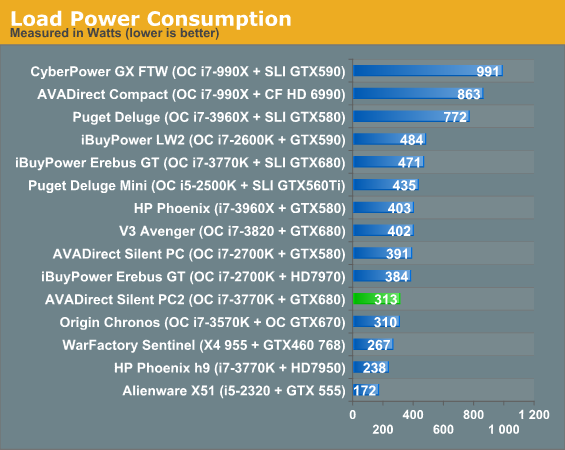
Frankly it's hard to argue with this kind of efficiency. AVADirect's system draws much less power than last generation's competitors while providing tangibly superior performance. Idle power draw is excellent, too.
Conclusion: Worth Considering In This Configuration
With the amount of performance in AVADirect's Quiet Gaming PC (SPCR Certified!) you're just not going to get a purely silent system. To get one, you'd have to sacrifice the overclock and the video card; in other words, you'd have to go for the Puget Systems Serenity SPCR Edition which I can attest is basically inaudible unless you put your ear right up against the side of the case. And if you want that system, you will pay dearly for the privilege.
There's a lot to like about what AVADirect has done here. Across the board, our review unit features only high quality component selection, right up to the very respectable Prolimatech Megahalems heatsink used on the CPU. AVADirect's engineers understand something I've been pushing in my case reviews: a series of small fans run at low speed can do a lot of work and be remarkably quiet in the process. It's all about having smart airflow. That's basically the case here. $2,700 is an awful lot to ask for a desktop, but at least you know they're not cheaping out anywhere.
Well, except for one place, and that one thing is the crack in the Quiet Gaming PC's armor. The NZXT H2 is a sub-optimal case. It puts in a solid performance here, certainly, but again, the H2 is a baseline for so many vendors because NZXT cuts massive deals to boutiques (which is why their cases can be so prevalent). If I wasn't a hardware reviewer with some behind the scenes experience I might not notice the difference, but I am, and I do. AVADirect does offer alternative enclosures, but that leads me to another question.
.jpg)
Okay, so the Quiet Gaming PC is certified by SPCR. In what configuration? The options AVADirect offers for component selection are thankfully more limited than they usually are in the places that matter (CPU heatsink and GPU options). Would that certification still hold if we changed the case to a theoretically quieter one like the Antec P183 or the Fractal Design Define XL, though? Or if we used a less powerful CPU cooler like the Scythe Mugen 3? It's tricky, and it's the reason why I still tend towards the Puget Systems Serenity for users who want a quiet system. You sacrifice the overclock and some GPU power by going with them, but the component selection is substantially whittled down to only the cream of the crop.
It undoubtedly seems like I'm being tough on AVADirect when the review system I was sent is actually a pretty excellent piece of engineering with a lot of love and care put into it. The value proposition on systems like these is never good; honestly what I really wish is that they'd sent a system in an Antec P183 or the Fractal Design Define XL so I could at least say with some measure of certainty whether or not those cases would be an improvement instead of operating on my knowledge of the NZXT H2, a case which just looks and feels too cheap for a $2,700 computer.
That's my only major complaint, though. If you want a lot of performance in a quiet build and you're not up to putting it together yourself, it's really hard to fault what AVADirect has done here. You'll pay substantially for it, but I can definitely see the market for this system. If you have the money for it and acoustics matter to you, you could do heck of a lot worse.

_thumb.jpg)
_thumb.jpg)
_thumb.jpg)
_thumb.jpg)
_thumb.jpg)






